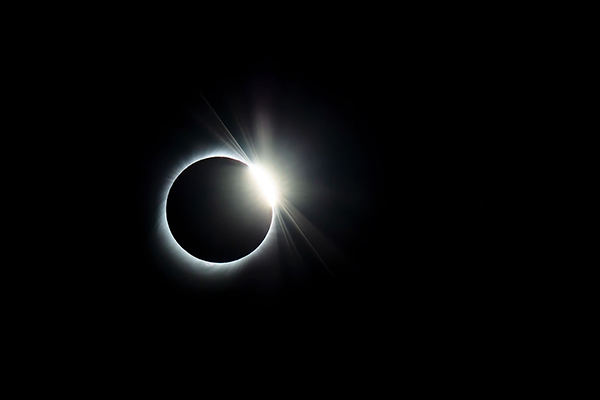Tamron Blogs
Share the article:
More Photo Tips | Video Gallery | Photo Gallery | Enewsletter sign-up
How To Photograph An Eclipse - Best Lens For Eclipse Photography

Image © Ian Plant
Click image to view larger
On April 8th, 2024, the celestial stage is set for a total solar eclipse that presents a unique opportunity for photographers to capture stunning images of the sun's corona as it briefly emerges during totality. A big question is “How to Photograph Eclipse?” Photographing a total eclipse requires careful planning, the right equipment, and precise execution. Here are some pro tips to ensure you capture this event and the best lenses to use for the job.
Plan Your Location
Choosing the right location is crucial for capturing a total eclipse. Research areas along the path of totality using a solar eclipse 2024 path of totality interactive map to find where the eclipse will be fully visible. Consider factors such as weather conditions, accessibility, and whether obstructions like buildings or trees could block your view when you choose your location. Many hotels along the path of totality are already sold out, so consider renting an RV or camping.
Use Proper Eye and Lens/Camera Protection
Using proper eye protection when photographing the eclipse is mandatory. Looking directly at the eclipse can cause permanent eye damage. Use certified solar eclipse glasses for your eyes and be sure to use a camera lens filter for a solar eclipse to protect both your eyes and your gear.
Arrive Early and Set Up Properly
Arrive at your chosen location well in advance to set up your equipment. Practice assembling your camera, tripod, and any additional accessories you plan to use. Familiarize yourself with the camera settings and make any necessary adjustments.
Choose the Best Lens for Eclipse Photography
Selecting the right lens is crucial for capturing the total eclipse effectively. A telephoto lens with a long focal length is ideal for photographing the sun's corona during totality. Lenses in the range of 200mm to 400mm are commonly recommended for this purpose. Using a longer ultra-telephoto zoom lens can magnify the details of the corona.
Recommended Lenses
1. TAMRON 50-400mm F/4.5-6.3 Di III VC VXD for Sony E-mount mirrorless cameras. Offering the recommended focal range for shooting the eclipse, the lens also offers the 50mm standard focal length to easily capture the excitement and festivities surrounding the eclipse viewing parties without changing lenses. Be sure to turn off the VC image stabilization when on a tripod. The lens will require a Ø67 solar eclipse filter.
2. TAMRON 150-500mm F/5-6.7 Di III VC VXD for Sony E, Fujifilm X and Nikon Z mirrorless cameras. This ultra telephoto lens offers the range needed for the eclipse while being a versatile light weight and compact lens for its class of lenses. Turn off the VC when on a tripod. The lens will require an Ø82 solar eclipse filter.
3. TAMRON 150-600mm F/5-6.3 Di VC USD G2 for Canon and Nikon DSLR cameras. This ultra-telephoto lens provides the focal range needed for capturing the eclipse for users of digital SLR cameras. This lens can also be used on mirrorless cameras when using the manufacturer adapter. Turn off the VC when on a tripod. The lens will require a Ø95 solar eclipse filter.
Necessary Gear
First and foremost, you will need a solar eclipse camera filter as previously stated. Do not attempt to photograph the eclipse without this filter as you will damage your eyes and your camera’s sensor. You will also need a sturdy tripod and a cable release to get images without any motion blur.
Best Camera Settings for Solar Eclipse Photography
Set your camera to manual mode. Use your lens' widest aperture and set the shutter speed to ensure you can capture a sharp image if you are shooting handheld. Bring up your ISO as necessary to achieve the desired exposure. Note that during totality, the brightness of the sun is greatly reduced, so a high ISO of 800 or higher might be necessary.
Be Patient
Photographing a total eclipse requires patience and lots of test shots over a quick period. Start taking shots as soon as the eclipse begins and adjust your shutter speed as needed to get the correct exposure, especially as the lighting conditions change during the 4-minute total eclipse.
Conclusion
The total solar eclipse 2024 is a great opportunity for photographers in the USA and Canada to capture stunning images of a total eclipse. The next total solar eclipse after 2024 will not be in North America for 20 years, in 2045. So, plan your trip today and by following these tips and using the recommended lenses, you can increase your chances of capturing photographs of the sun's corona during totality. Remember to prioritize safety and plan ahead for the best success. And lastly, enjoy the event, the festivities, and the community forged around the total solar eclipse.
More Photo Tips | Watch Videos | Learn More About Tamron Lenses | Photo Gallery